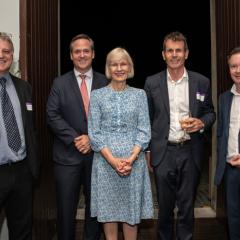The Independent Expert Scientific Committee on Coal Seam Gas and Large Coal Mining Development (IESC) visited the UQ Centre for Coal Seam Gas (CCSG) for research briefings and a lab tour last week. The committee provides scientific advice to decision makers on the impacts coal seam gas and large coal mining developments may have on Australia’s water resources.
IESC members possess strong scientific qualifications and expertise in the fields of hydrogeology, hydrology, ecology, geology, ecotoxicology, and environment protection. The IESC aims to improve the collective scientific understanding of the water-related impacts of coal seam gas and large coal mining developments through an independent and transparent process that builds confidence in the science used in decision making.
The University of Queensland, via the Centre for Coal Seam Gas, together with the Centre for Water in the Minerals Industry and the School of Earth and Environmental Science, is a leader in CSG-related water research, both in terms of groundwater characterisation and engineering solutions. The Centre is supporting multi-disciplinary research which is throwing a new light onto our understanding of GAB complexity.
A number of researchers from CCSG gave short briefings to the eight committee members and accompanying staff on actual water production vs. pre-development predictions, reductions in predicted salt volumes, new understanding of water recharge dynamics and locations, the 3D Water Atlas (a publically available, transparent view of groundwater variability over time and space), natural variations in water chemistry and hydrocarbons, characterizing heterogeneity etc.
The visit concluded with a lab tour in the School of Chemical Engineering to see the new UQ, high pressure, well simulator facility for plugging oil and gas wells with novel materials (e.g. hydrated bentonite). In the lab, the committee also watched a demonstration of the large scale, experimental well bore for investigating and measuring gas and water flows and their interaction.



